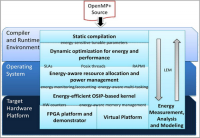Research Projects
GEMSCLAIM: GreenEr Mobile Systems by Cross LAyer Integrated energy Management
Personal computing currently faces a rapid trend from desktop machines towards mobile services, accessed via tablets, smartphones and similar terminal devices. With respect to computing power, today´s handheld devices are similar to Cray-2 supercomputers from the 1980s. Due to higher computational load (e.g. via multimedia apps) and the variety of radio interfaces (such as WiFi, 3G, and LTE), modern terminals are getting increasingly energy hungry. For instance, a single UMTS upload or a video recording process on today´s smartphones may consume as much as 1.5 Watts, i.e. roughly 50% of the maximal device power. In the near future, higher data rates and traffic, advanced media codecs, and graphics applications will ask for even more energy than the battery can deliver. At the same time, the power density limit might lead to a significant share of “Dark Silicon” at 22nm CMOS and below. Obviously, disruptive energy optimizations are required that go well beyond traditional technologies like DVFS (dynamic voltage and frequency scaling) and power-down of temporarily unused components.
The GEMSCLAIM project aims at introducing novel approaches for reducing this “greed for energy”, thereby improving the user experience and enabling new opportunities for mobile computing. The focus is on three novel approaches: (1) cross layer energy optimization, ranging from the compiler over the operating system down to the target HW platform, (2) efficient programming support for energy-optimized heterogeneous Multicore platforms based on energy-aware service level agreements (SLAs) and energy-sensitive tunable parameters, and (3) introducing energy awareness into Virtual Platforms for the purpose of dynamically customizing the HW architecture for energy optimization and online energy monitoring and accounting. GEMSCLAIM will provide new methodologies and tools in these domains and will quantify the potential energy savings via benchmarks and a HW platform prototype.
Gabriel GIRBAN, Lucian BARA



